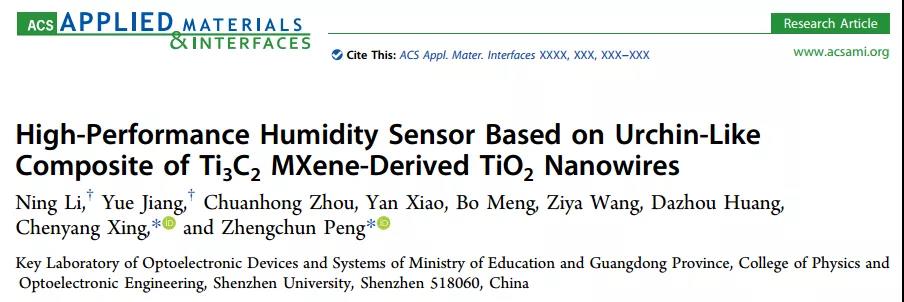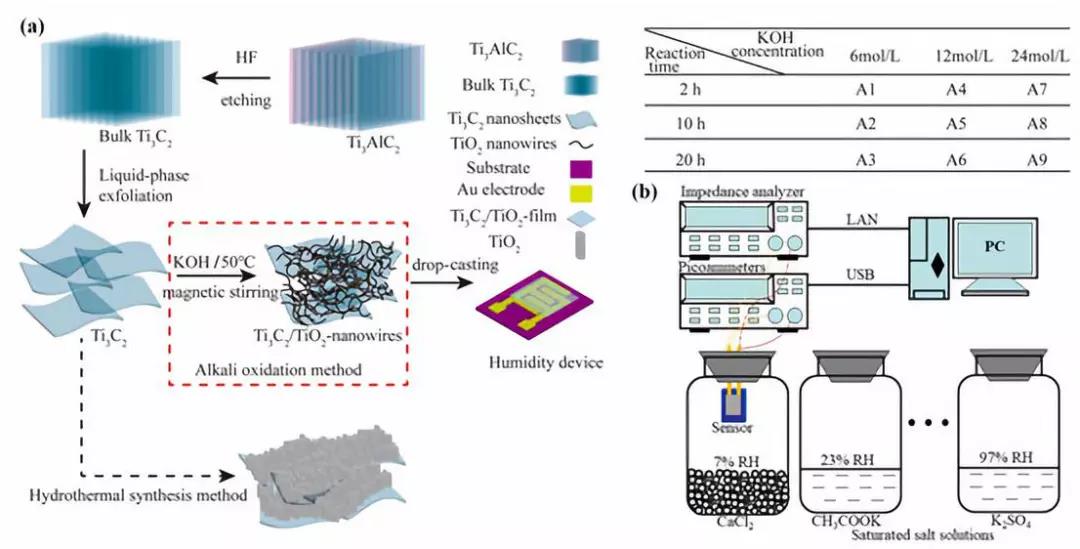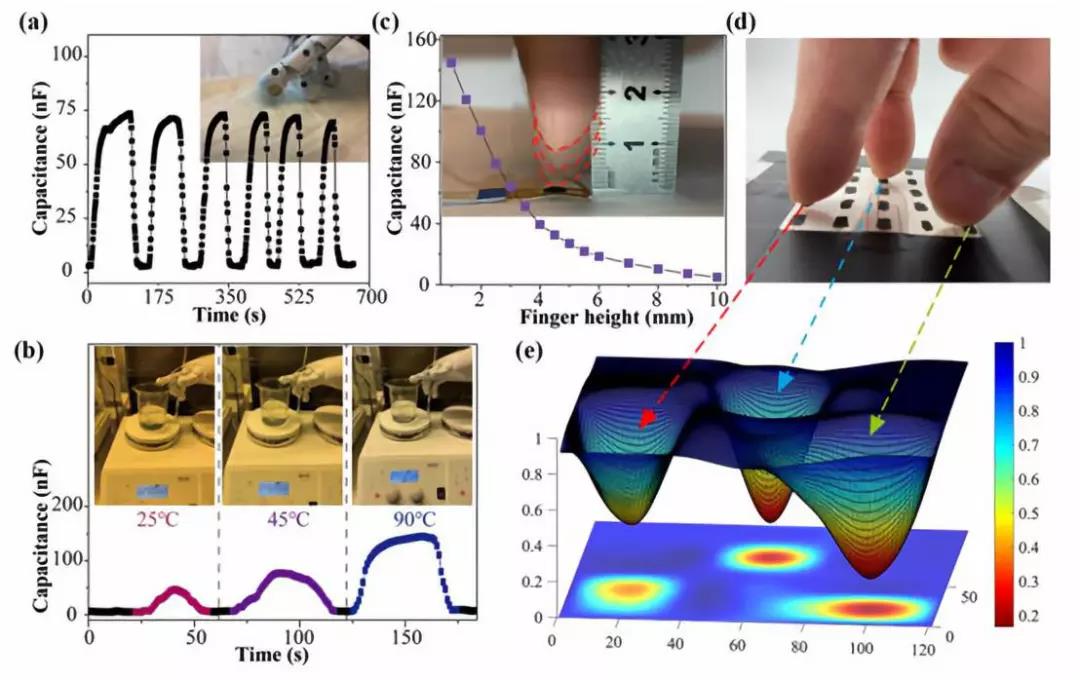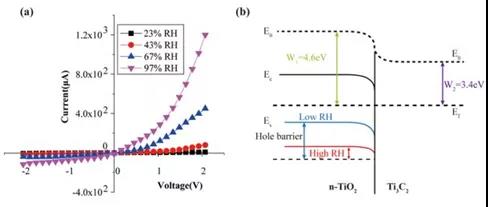
hotline:
17715390137
Tel/Wechat:
18101240246 (Technology)
0512-68565571
Email:mxenes@163.com (Sales Engineer)bkxc.bonnie@gmail.com
Scan the code to follow or search the official account on WeChat:
2D Materials Fronrier After paying attention,
click on the lower right corner to contact us,
Enter enterprise WeChat.
Professional Services Online


【Research Background】
Humidity testing is an important subject in health care work, such as during breathing and emotional testing. To date, researchers have studied a variety of nanomaterials such as graphene oxide, MoS2, metal oxides and nanohybrides as moisture sensing materials. These types of humidity sensors can be used to miniaturize low-energy wearable electronic devices. However, such devices typically have poor sensitivity at lower relative humidity (RH) levels (<40% RH).
[Introduction]
Recently, Associate Professor Xing Chenyang and Professor Peng Zhengchun from Shenzhen University reported a functional MXene material for humidity sensor devices by using a base to oxidize and in situ TiO2 nanowires on two-dimensional Ti3C2 MXene. Compared to pure Ti3C2 or TiO2 materials, the prepared MXene material has an order of surface area that is an order of magnitude higher. This Ti3-C2/TiO2 composite with a seashell-like appearance exhibits unprecedented sensitivity in a low relative humidity (RH) environment. The potential sensing mechanism of Ti3C2/TiO2 composites under different humidity conditions is explained by complex impedance spectroscopy and Schottky junction theory. It is verified that the humidity sensor made of Ti3C2/TiO2 composite material is used for various liquids and human fingers. Application in non-contact detection.
The results are published online in ACS Applied Materials & Interfaces: High-Performance Humidity Sensor Based on Urchin-Like Composite of Ti3C2 MXene-Derived TiO2 Nanowires.
[Graphic introduction]

Figure 1 (a) Material preparation process: HF etching, LPE, alkali oxidation and the like. (b) Schematic diagram of the experimental device

Figure 2 (a) Humidity response of Ti3C2 / TiO2 composites prepared under different conditions (samples A1-A9). (b) Comparison of moisture sensitivity of bulk TiO2, Ti3C2 nanosheets, Ti3C2/TiO2 composites prepared by hydrothermal method and Ti3C2/TiO2 composites prepared by alkali oxidation (sample A5). (c) The relationship between the capacitance of sensor A5 and the operating frequency at different relative humidity. (d) The relationship between the capacitance output of sensor A5 and RH. (e) Response and recovery characteristics of sensor A5 exposed to a range of RH conditions. (f) Repeatability of sensor A5 exposed to 33% RH, 54% RH and 84% RH, respectively. (g) Hysteresis curve of the adsorption-desorption response measured in the range of 7-97% RH. (h) Stability of sensor A5 for 40 days under different humidity conditions.

Figure 3 Humidity fluctuations are reflected by the capacitive output of the humidity sensor integrated into the fingers of the robot close to the wet diaper. (a) The height-resolved capacitance map of the near surface of the fingertip measured by the established humidity sensor at different temperatures (b) and (c). (d) A photograph of the three fingertip positions above the 5 x 5 matrix. (e) 3D maps of three fingertips that are close.

Figure 4 (a) Schematic diagram of the adsorption process of water molecules on a Ti3C2 / TiO2 composite membrane. Complex impedance diagram of Ti3C2 / TiO2 complex impedance map of Ti3C2 / TiO2 composite film at 7-23% RH (b) and 33-97% RH(c), (b, c) illustration: EC corresponds to complex impedance spectrum (CIS) spectrum. (d) Bode plot of Ti3C2/TiO2 composite under different RH conditions. (e) Complex impedance map of pure Ti3C2 film.

Figure 5 (a) I-V curves of Ti3C2/TiO2 composite films measured at different RH levels. (b) Energy band diagram of Ti3C2 / TiO2 composite film (E0 vacuum level; W work function; Ef Fermi level; EC conduction band; EV valence band)
[Summary of this article]
In this study, a humidity sensor based on Ti3C2/TiO2 composite was prepared by oxidizing Ti3C2 in an alkaline KOH solution. The sensor has a very high specific surface area and is more sensitive than pure Ti3C2 or pure TiO2 sensors, especially at low relative humidity. The potential sensing mechanism of Ti3C2/TiO2 composites is analyzed by CIS and Bode diagrams. The Ti3C2/TiO2 Schottky barrier also helps to improve the sensitivity of composites in low humidity environments. The sensor can detect the humidity of the diaper and the temperature level of the water in a non-contact manner, and can monitor the proximity of the fingertip, indicating that it has great potential in health and environmental protection as well as human-computer interaction and robotics.
Literature link:
Https://doi.org/10.1021/acsami.9b12168
Source: WeChat public account MXene Frontier

| Reminder: Beijing Beike New Material Technology Co., Ltd. supplies products only for scientific research, not for humans |
| All rights reserved © 2019 beijing beike new material Technology Co., Ltd 京ICP备16054715-2号 |